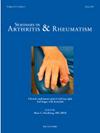Self-directed versus supervised exercise therapy program combined with digitally supported patient education for knee osteoarthritis: a randomised, parallel-group feasibility trial
IF 4.4
2区 医学
Q1 RHEUMATOLOGY
引用次数: 0
Abstract
Introduction
Research comparing self-directed and supervised exercise therapy for knee osteoarthritis (KOA) is limited. This study evaluates the feasibility of a randomised controlled trial (RCT) comparing self-directed and supervised exercise therapy combined with education for people with KOA.
Materials and methods
Participants with a clinical diagnosis of KOA, living in Greater Melbourne, were recruited via advertisements on community notice boards and on social media. Each attended two online education sessions and accessed the web-based ‘My Knee’ education and self-management toolkit to support their learning and exercise completion. Participants were then randomised to self-directed or supervised exercise therapy and encouraged to complete ≥12 exercise therapy sessions (2x week) over at least six weeks. Feasibility outcomes included recruitment, retention, data completion (monitored by checking the completion status of the questionnaires), education and exercise therapy sessions completion. Between group differences for Knee Injury and Osteoarthritis Outcome Score-12 (KOOS-12) and European Quality of Life 5 Dimensions 5-Level Version (EQ-5D-5L) estimated whether treatment effects were clinically meaningful (i.e. minimal detectable change contained within the 95 % confidence interval).
Results
Over 6-months, 67 people expressed interest, 26 were eligible, and 24 consented to participate. All participants attended both education sessions, and none dropped out. Eighty-eight percent (15/17) of self-directed and 57 % (4/7) of the supervised participants completed the logbook. Completed logbook data indicated ≥12 exercises sessions were completed by 93 % of self-directed and all supervised participants. All feasibility criteria were met, or can be addressed in future trials. Clinically meaningful treatment effects were contained within the 95 % CI for all KOOS-12 subscales and the EQ-5D-5L in the self-directed group.
Conclusion
A larger-scale non-inferiority RCT is feasible, with strategies to increase recruitment rate and data completion.
Trial registration
ANZCTR Registration (ACTRN12623000123640).
自主与监督运动治疗方案结合数字支持的膝关节骨关节炎患者教育:一项随机平行组可行性试验
比较自主和监督运动治疗膝关节骨关节炎(KOA)的研究是有限的。本研究评估了一项随机对照试验(RCT)的可行性,该试验比较了自我指导和监督运动疗法结合教育对KOA患者的影响。材料和方法通过社区公告板和社交媒体上的广告招募居住在大墨尔本的临床诊断为KOA的参与者。每个人都参加了两个在线教育课程,并访问了基于网络的“我的膝盖”教育和自我管理工具包,以支持他们的学习和锻炼完成。然后,参与者被随机分配到自我指导或监督运动治疗组,并被鼓励在至少6周的时间内完成≥12次运动治疗(2周)。可行性结果包括招募、保留、数据完成情况(通过检查问卷的完成情况来监测)、教育和运动治疗的完成情况。膝关节损伤和骨关节炎结局评分-12 (KOOS-12)和欧洲生活质量5维度5级版本(EQ-5D-5L)的组间差异估计治疗效果是否具有临床意义(即95%置信区间内的最小可检测变化)。结果在6个月的时间里,67人表示有兴趣,26人符合条件,24人同意参与。所有参与者都参加了两次教育课程,没有人退出。88%(15/17)的自我指导参与者和57%(4/7)的监督参与者完成了日志。完成的日志数据表明,93%的自我指导和所有受监督的参与者完成了≥12个锻炼课程。所有的可行性标准都被满足,或者可以在未来的试验中解决。所有KOOS-12亚量表和自我导向组EQ-5D-5L的临床意义治疗效果均在95% CI范围内。结论开展大规模非劣效性随机对照试验是可行的,并采取相应的策略提高招募率和数据完成率。试验注册anzctr注册(ACTRN12623000123640)。
本文章由计算机程序翻译,如有差异,请以英文原文为准。
求助全文
约1分钟内获得全文
求助全文
来源期刊
CiteScore
9.20
自引率
4.00%
发文量
176
审稿时长
46 days
期刊介绍:
Seminars in Arthritis and Rheumatism provides access to the highest-quality clinical, therapeutic and translational research about arthritis, rheumatology and musculoskeletal disorders that affect the joints and connective tissue. Each bimonthly issue includes articles giving you the latest diagnostic criteria, consensus statements, systematic reviews and meta-analyses as well as clinical and translational research studies. Read this journal for the latest groundbreaking research and to gain insights from scientists and clinicians on the management and treatment of musculoskeletal and autoimmune rheumatologic diseases. The journal is of interest to rheumatologists, orthopedic surgeons, internal medicine physicians, immunologists and specialists in bone and mineral metabolism.

 求助内容:
求助内容: 应助结果提醒方式:
应助结果提醒方式:


